Porcelain Insulator News
by Elton Gish, NIA #41
Reprinted from "Crown Jewels of the Wire", March 1992, page 5
First I want to send a very special THANK YOU to Bob Stahr. Bob is an
architecture student at Iowa State University in Ames, Iowa where he has become
very interested in researching our hobby in his spare time. He has spent
hundreds of hours digging through old electrical trade journals. I sent Bob my
want list of trade journal articles, and he has found nearly all of them, plus
countless others. Thanks Bob for taking an interest in this part of insulator
collecting, and for making the many Xerox copies for my files. Thanks to Bob's
efforts, and the sharing of research files by several other collectors, we now
have almost 700 trade journal articles and 535 advertisements on file! If any of
you have a special historical interest, please feel free to drop me a line.
Maybe there is something in the files that you can use. I will be glad to send
you a Xerox copy for a small fee to cover expenses.
As usual, there have been a lot of reports of new multipart finds. Several of
these are very exciting for the classic collector.
Tim Wood, as you may recall
from PIN in April, 1991 Crown Jewels, reported a fourth turquoise M-2636. Now to
top that off, Tim sends in a couple of equally nice reports. The first one is
M-3150A. What makes this piece so special is that, on the side of the crown, is
the incuse marking, "JOHNS-MANVILLE". Have any of you ever heard of
this one? It has been a very long time since we talked about this marking. The
two photographs on the following page show Tim's M-3150A and a close-up of the
marking.
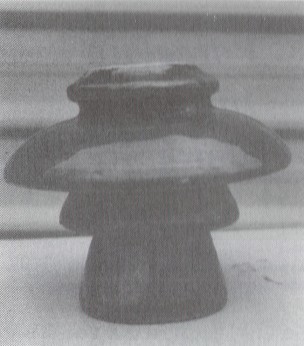
Johns-Manville M-3150A
The "JOHNS-MANVILLE" marking is very rare with only about four
multipart specimens known. It is also rare on the only marked unipart style,
U-241A, but the marked U-241A's are much more common than marked multiparts. All
of the U-241A specimens have a mahogany brown glaze with the exception of a
single marked white specimen!! So far, only four multiparts are known with this
marking: M-2140 (two reported), M-2635, and M-3150A, and only one specimen of
the last two have been reported.
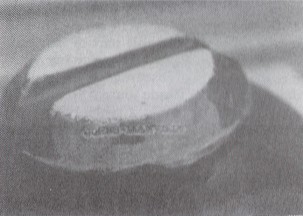
Johns-Manville M-2140
From 1900-1910, Johns-Manville jobbed insulators made by Ohio Brass, Thomas
and New Lexington. The U-241A was made for Johns-Manville by the Pittsburg High
Voltage Insulator Co., and the marked multiparts were known to have been made by
New Lexington High Voltage Porcelain Co. as evidenced by marked multipart pieces
Jack Tod found at the New Lexington dump. However, the color of Tim's M-3150A
looks more like an Ohio Brass product.
Tim's other report is an exciting find,
too. When I was looking for catalog styles to put in the M-Chart, I ran across a
three-part style in the 1904 Thomas catalog, but the illustration was a tad
irregular to include since it showed the insulator at an odd angle, and, too,
the illustration did not reproduce very well. Even so, I finally decided to
include it in the M-Chart and assigned it M-3280. A number of other very early
catalog styles were included, too, even though these may never be found by
collectors.
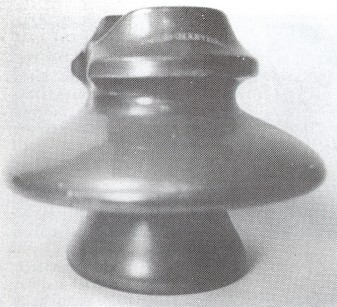
Johns-Manville M-2140
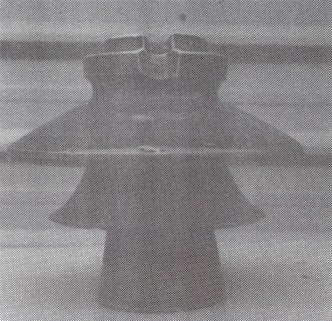
Thomas M-3280
The photo above is a specimen of M-3280 that Tim found, and it matches
closely with the estimated dimensions of the catalog illustration! It has the
square-sided crown so distinctive of Thomas from the pre-1910 era. The glaze
color is a very light, yellowish-tan glaze, and there are "blue-jean
seam" marks inside the bottom
skirt which is so characteristic of early Thomas production. Many specimens
of various styles confirm that these "blue-jean seam" marks were used
before 1910. In fact, this yellowish-tan glaze and mottling is identical to the
glaze on the two known specimens of U-967 (see CJ, 6-91-8). A close-up
photograph of the "blue-jean seam" marks, which are only found on
Thomas specimens is shown below. On some specimens, you can actually see the
crosshatch of the denim material and the stitches along the seam, as if they
used pants leg rejects or cutoffs from a Levis factory. Maybe they had problems
with the soft clay sticking to the plunger that formed the inside of the bottom
skirts, but why just the bottom skirts? Some of these marks show two seams and
some show only one seam.
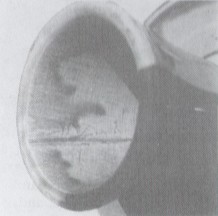
Thomas "blue-jean" seam and
denim marks on U-967
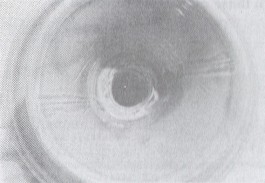
Thomas "blue-jean" seam and
denim marks on M-2242
While on the subject of New Lexington, we may as well
describe the various marked specimens that were made by them. These specimens
bear the very rare marking: "NEW LEXINGTON, O." This marking on multi
parts is almost as rare as the Johns-Manville marking. At the top of the
following page is a photograph of the broken crown of a very large multipart
insulator that Jack Tod found in the New Lexington dump in the early 1970's. Jack
mailed this piece to me a few years ago after sending a note to say that he was
sending me a "near mint insulator". What a surprise it was to open
that box! Needless to say, it was not even close to "near mint", but a
nice display piece nonetheless. I would guess that it came from a very large
four-part insulator similar to M-4380, or possibly a M-3890, since the crown
diameter is 6-1/2 inches. You will see a similar four-part insulator with the large, square-sided crown in the . 1909
New Lexington advertisement on page 127 of my book, Multi-part Porcelain
Insulators.
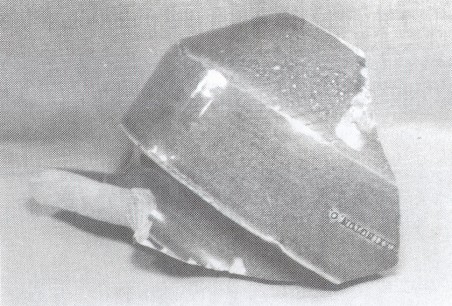
Old multipart crown marked "NEW LEXINGTON, O."
The glaze on the broken crown specimen is a nice medium speckled
tan. Glaze color can be quite varied and far from definitive for New Lexington.
Colors range from light blonde or butterscotch tan, medium speckled tan, dark
mahogany, and near black.
Only three unipart styles are known with the New
Lexington marking, U-552, U-746, and U-966A (for this last style, see CJ
7-90-16). U-746 is the most commonly marked style with maybe a dozen or more
specimens. Only one specimen of U-552 is known and I do not know who owns it now
(???). Possibly three specimens of U-966A are known.
There are only three known
multipart styles with the New Lexington marking: M-2440 (one specimen known,
dark mahogany), M-2637 (one specimen known, light tan top, blonde tan bottom),
and M-2841 (2 or 3 known, black with some lighter mottling). New Lexington
marked multiparts are very rare.
I keep hearing rumors of larger marked styles,
but these cannot be confirmed. The latest reported rumor was that either a
3-part or 4-part New Lexington marked specimen traded hands at the Meriden, CT
Eastern Regional this year. I never could confirm this report. If any of you have
a marked New Lexington, especially one not known to us, PLEASE write to me and include a
photograph and dimensions. Any new styles need to be included in the next edition
of my book.
Likewise, if you have any multipart styles that are not in my book, please
let me know so they can be included, too. The next edition is just a year away
and will have 130 new multipart styles.
Ken Willick has reported a very unusual,
almost unbelievable, marking that he found on broken crowns from M-3890 along
the Niagara, Lockport & Ontario power line. Jack Tod also found a broken
skirt piece from a multipart at the New Lexington dump in the early 1970's which
had this same marking. The marking shown in the photo below is: "Patented
June 17, 1890/ New Lexington, O."
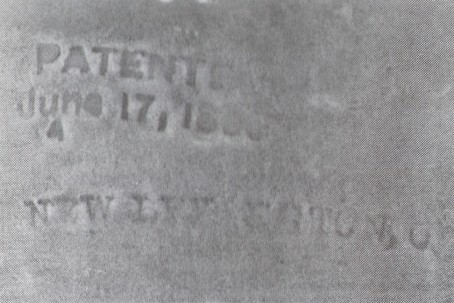
This is the Oakman patent for the dove-tail ears on helmet styles, CD 259,
CD 260 and CD 257!! ! ! ! I cannot conceive why New Lexington, who almost never
put a marking of any kind on their insulators (Their 1908 catalog did not show a
helmet style!), would decide to include an Oakman patent on a multipart
porcelain insulator. This should be in "Believe-It-Or-Not"!
The New
Lexington crown that Ken sent me with the above marking is six inches in
diameter (1/2 inch smaller than the previously mentioned crown Jack found), and
it has a beautiful butterscotch tan glaze! Wouldn't you like to see a whole one
of these! I would guess that it is the crown from M-3890 since the original line
was installed with Thomas M-3890' s in the first half of 1906. A second parallel
line was installed in 1907 to bring the total number of M-3890's to 23,000.
Albeit that the order was too large for one company, so part of the order was
given to New Lexington. To give you an idea of the size of the New Lexington crown, below is a photograph comparing it with a brown
U-928 Boch patent.
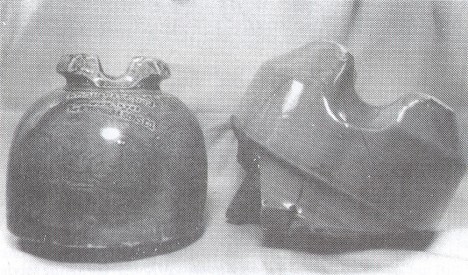
Brown U-928 and New Lexington M-3890 crown
I just found in my files (Jack's old files) a letter to Jack Tod dated 1972
from the New Lexington, Ohio historian. She said that one customer of New
Lexington insulators was the Niagara, Lockport & Ontario power plant. We can
now confirm that fact after twenty years. Another interesting item from that
letter is the following New Lexington slogan: "High Potential Insulators
for the Transmission of Great Power." The historian further stated that
they sent more insulators to the Pacific Coast power plants than all its
competitors! ! Now, where are all those New Lexington insulators!? West coast
collectors start looking up!
Ken also found broken pieces along the Niagara,
Lockport & Ontario line of what appear to be dark mahogany brown M-3890's
made by Thomas. He sent me a crown with part of the top skirt attached that had
an unusual marking on the side of the crown. The marking (3/8 of an inch tall)
shown in the photo on the following page does look like a Thomas style marking.
The marking is : MAY 20.
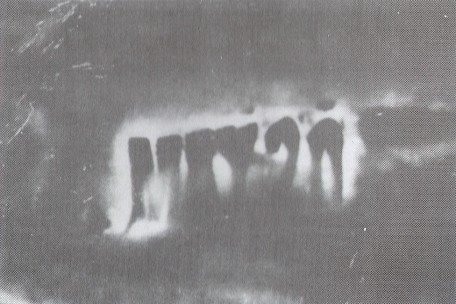
"MAY 20" marking on Thomas M-3890 crown
The Thomas crown is seven inches in diameter which is one inch larger than
the New Lexington crown. I suspect that the "MAY 20" date refers to
May 20. 1906. This would thus be one of the original insulators installed before
the line was put into operation on July 7, 1906. To give you an idea of the size
of the New Lexington crown, below is a photograph comparing it with the same
brown U-928 Boch patent. If you are wondering about the brown U-928, it is a
rare color for these typically white insulators. As I recall, only about a dozen or so
were ever found (sometime in the late 1970's I think), and all from the same
line!
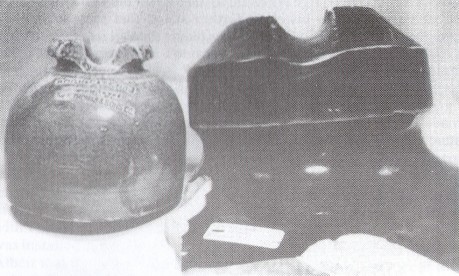
Brown U-928 and Thomas "MAY 20" M-3890 crown
Ken further reports that he also found along that line, broken specimens
of Ohio Brass M-4395 and light greenish gray pieces of what he believes to be
M-4338 with VICTOR stamped on each skirt. The M-4338 was the first replacement
four-part for the M-3890's that were so heavily damaged by lightning. The first
M-4338' s were installed in 1909. Most were used on the top of the pole where it
was believed that the lightning did the most damage. Again, we see two
manufacturers of the four-part style as were used for M-3890.
You will not find
M-4395 in my book, Multipart Porcelain Insulators along with 129 other "new" multipart styles. I
am working on a second revision of the book that should be available next year.
There are a lot of unusual styles that will be included, most of which we do not
have the time to publish in PIN. It will also include details on over 120 old
power lines, list of known multipart styles, and several pages of fantastic
color photos from Bill Rohde and Robin Harrison. Bill has captured on film
several unusual styles still in service. A couple of these may never be saved,
but Bill will be keeping a watchful eye on them if and when they do come down.
By the way, M-4395 is the gray Ohio Brass crosstop that 3 or 4 people have in
their collection. Look for photos of this circa 1909 insulator in a future
"Porcelain Insulator News".
| 